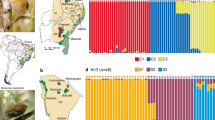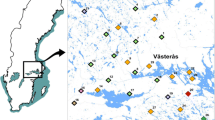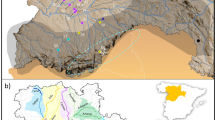Abstract
Species’ geographic ranges may vary in size in response to a change in environmental conditions. The specific genetic consequences of range expansions are context dependent, largely depending upon the rate of colonisation as well as the origins and numbers of founders, and the time since colonisation. Like other “charismatic” taxa, such as birds and lepidopterans, the distributions of odonates (dragonflies and damselflies) are well-known through substantial monitoring programmes co-ordinated by various societies. The small red-eyed damselfly Erythromma viridulum (Odonata: Zygoptera) has undergone a substantial, northward range expansion in Europe in the last 30 years and has recently-colonised two distinct areas in the UK. We quantify the immediate genetic consequences of this rapid colonisation by genotyping more than 1,400 E. viridulum from 39 sites across the northwest margin of this species’ geographic range. Levels of genetic diversity and spatial structure are impacted by this species recent range expansion and non-equilibrium conditions that drive weak genetic divergence, even at regional spatial scales. Populations of E. viridulum become less diverse towards the edge of this species’ distribution, presumably as a consequence of colonisation through a series of founder events. Specifically, there is a significant reduction in genetic diversity in the smallest, most recent focus of colonisation in the UK; however, there are generally low levels of genetic diversity across this E. viridulum’s northern range margin. While most populations are generally poorly differentiated, E. viridulum nonetheless consists of two distinct lineages that broadly differentiate between eastern and western Europe. Genetic divergence between the two UK colonisation foci are indicative of distinct immigration events from separate sources; however a general lack of spatial structure prevents us from pinpointing the specific origins of these migrant damselflies.






Similar content being viewed by others
References
Ahern RG, Hawthorne DJ, Raupp MJ (2009) Founder effects and phenotypic variation in Adelges cooleyi, an insect pest introduced to the eastern United States. Biol Invasions 11:959–971
Aljanabi SM, Martinez I (1997) Universal and rapid salt-extraction of high quality genomic DNA for PCR-based techniques. Nucleic Acids Res 22:4692–4693
Andrés RA, Sanchez-Guillën RA, Cordero-Rivera A (2002) Evolution of female color polymorphism in damselflies: testing the hypotheses. Anim Behav 63:677–685
Aoki T (1997) Northward expansion of Ictinogomphus pertinax (Selys) in eastern Shikoku and western Kinki districts, Japan (Anisoptera: Gomphidae). Odonatologica 26:121–133
Askew R (1988) Dragonflies of Europe. Harley Books, Martins, UK
Cham S (2001) The status of small red-eyed damselfly Erythromma viridulum in the British Isles. Atropos 12:7–9
Cham S (2002) Range expansion of the small red-eyed damselfly Erythromma viridulum (Charp.) in the British Isles. Atropos 15:3–9
Cham S (2004) Observations on an inland population of the small red-eyed damselfly Erythromma viridulum (Charpentier) with notes on the discovery of the first larvae in Britain. J Br Dragonfly Soc 20:31–34
Chaput-Bardy A, Lemaire C, Picard D, Secondi J (2008) Spatial genetic structure in a large river network. Mol Ecol 17:3496–3505
Chen YH, Opp SB, Berlocher SH, Roderick GK (2006) Are bottlenecks associated with colonization? Genetic diversity and diapauses variation of native and introduced Rhagoletis completa populations. Oecologia 149:656–667
Ciofi C, Beaumont MA, Swingland IR, Bruford MW (1999) Genetic divergence and units for conservation in the Komodo dragon Varanus komodoensis. Proc R Soc Lond B266:2269–2274
Cornuet JM, Luikart G (1996) Description and power analysis of two tests for detecting recent population bottlenecks from allele frequency data. Genetics 144:2001–2014
De Kniff G, Anselin A, Goffart P (2001) Trends in dragonfly occurrence in Belgium (Odonata). Proceedings of the 13th international colloquium European invertebrate survey, Leiden
Dewick S, Gerussi R (2000) Small red-eyed damselfly Erythromma viridulum (Charpentier) found breeding in Essex—the first British Records. Atropos 9:3–4
Dlugosch KM, Parker IM (2008) Founding events in species invasions: genetic variation, adaptive evolution, and the role of multiple introductions. Mol Ecol 17:431–449
Evanno G, Regnaut S, Goudet J (2005) Detecting the number of clusters of individuals using the software structure: a simulation study. Mol Ecol 14:2611–2620
Gabbard B, Fowler N (2007) Wide ecological amplitude of a diversity-reducing invasive grass. Biol Invasions 9:149–160
Genton BJ, Shykoff JA, Giraud T (2005) High genetic diversity in French invasive populations of common ragweed, Ambrosia artemisiifolia, as a result of multiple sources of introduction. Mol Ecol 14:4275–4285
Gloster J, Burgin L, Witham C, Athanassiadou M, Mellor PS (2007) Bluetongue in the United Kingdom and northern Europe in 2007 and key issues for 2008. Vet Rec 162:298–302
Goodisman MAD, Matthews RW, Crozier RH (2001) Hierarchical genetic structure of the introduced wasp Vespula germanica in Australia. Mol Ecol 10:1423–1432
Goudet J (1995) FSTAT (vers. 1.2): a computer program to calculate F-statistics. J Hered 86:485–486
Grapputo A, Boman S, Lindström L, Lyytinen A, Mappes J (2005) The voyage of an invasive species across continents: genetic diversity of North American and European Colorado potato beetle populations. Mol Ecol 14:4207–4219
Hardy OJ, Vekemans X (2002) SPAGeDi: a versatile computer program to analyse spatial genetic structure at the individual or population levels. Mol Ecol Notes 2:618–620
Hassall C, Thompson DJ, French GC, Harvey IF (2007) Historical changes in the phenology of British Odonata are related to climate. Glob Change Biol 13:933–941
Herborg L-M, Weetman D, van Oosterhout C, Hanfling B (2007) Genetic population structure and contemporary dispersal patterns of a recent invader, the Chinese mitten crab, Eriocheir sinensis. Mol Ecol 16:231–242
Hewitt GM (2000) The genetic legacy of the Quaternary ice ages. Nature 405:907–913
Hickling R, Roy DB, Hill JK, Thomas CD (2005) A northward shift of range margins in British Odonata. Glob Change Biol 11:502–506
Hickling R, Roy DB, Hill JK, Fox R, Thomas CD (2006) The distributions of a wide range of taxonomic groups are expanding polewards. Glob Change Biol 12:1–6
Hill JK, Thomas CD, Huntley B (1999) Climate and habitat availability determine 20th century changes in a butterfly’s range margin. Proc R Soc Lond B266:1197–1206
Johnson RN, Starks PT (2004) A surprising level of genetic diversity in an invasive wasp: Polistes dominulus in the northeastern United States. Ann Entomol Soc Am 97:732–737
Keat S, Thompson DJ, Kemp SJ, Watts PC (2005) Ten microsatellite loci for the small red-eyed damselfly Erythromma viridulum (Charpentier). Mol Ecol Notes 5:788–790
Ketelaar R (2002) The recent expansion of the Small Red-eyed Damselfly Erythromma viridulum (Charpentier) in The Netherlands. J Br Dragonfly Soc 18:1–9
Kolbe JJ, Glor RE, Schettino LRG, Lara AC, Larson A, Losos JB (2004) Genetic variation increases during biological invasion by a Cuban lizard. Nature 431:177–181
Loiselle BA, Sork VL, Nason J, Graham C (1995) Spatial genetic structure of a tropical understorey shrub, Psychotria officinalis (Rubiaceae). Am J Bot 82:1420–1425
Michiels NK, Dhondt AA (1991) Characteristics of dispersal in sexually mature dragonfiies. Ecol Entomol 16:449–459
Nobes G (2003) Southern emerald damselfly Lestes barbarus (Fabr.)-the first British record. Atropos 18:3–6
Parmesan C, Yohe G (2003) A globally coherent fingerprint of climate change impacts across natural systems. Nature 421:37–42
Parr AJ (2005) Migrant and dispersive dragonflies in Britain during 2004. J Br Dragonfly Soc 21:14–20
Pearson RG, Dawson TP (2003) Predicting the impacts of climate change on the distribution of species: are bioclimate envelope models useful? Glob Ecol Biogeogr 12:361–371
Pérez JE, Nirchio M, Alfonsi C, Muñoz C (2006) The biology of invasions: the genetic adaptation paradox. Biol Invasions 8:1115–1121
Piry S, Luikart G, Cornuet J-M (1999) BOTTLENECK. A program for detecting recent effective population size reductions from allele frequency data. http://www.ensam.inra.fr/URLB
Pritchard JK, Wen W (2003) Documentation for structure software: version 2. http://pritch.bsd.uchicago.edu
Pritchard JK, Stephens M, Donnelly P (2000) Inference of population structure using multilocus genotype data. Genetics 155:945–959
Puillandre N, Dupas S, Dangles O, Zeddam J-L, Capdevielle-Dulac C, Barbin K, Torres-Leguizamon M, Silvain J-F (2008) Genetic bottleneck in invasive species: the potato tuber moth adds to the list. Biol Invasions 10:319–333
Ramachandran S, Deshpande O, Roseman CC, Rosenberg NA, Feldman MW, Cavalli-Sforza LL (2005) Support from the relationship of genetic and geographic distance in human populations for a serial founder effect originating in Africa. Proc Natl Acad Sci USA 102:15942–15947
Raymond M, Rousset F (1995) GENEPOP (version 1.2): population genetics software for exact tests and ecumenicism. J Hered 86:248–249
Rice WR (1989) Analyzing tables of statistical tests. Evolution 43:223–225
Rousset F (1997) Genetic differentiation and estimation of gene flow from F-statistics under isolation by distance. Genetics 145:1219–1228
Saccheri I, Kuussaari M, Kankare M, Vikman P, Fortelius W, Hanski I (1998) Inbreeding and extinction in a butterfly metapopulation. Nature 392:491–494
Sakai AK, Allendorf FW, Holt JS, Lodge DM, Molofsky J, With KA, Baughman S, Cabin RJ, Cohen JE, Ellstrand NC, McCauley DE, O’Neil P, Parker IM, Thompson JN, Weller SG (2001) The population biology of invasive species. Annu Rev Ecol Syst 32:305–332
Schmid-Hempel P, Schmid-Hempel R, Brunner PC, Seeman OD, Allen GR (2007) Invasion success of the bumblebee, Bombus terrestris, despite a drastic genetic bottleneck. Heredity 99:414–422
Schneider S, Roessli D, Excoffier C (2000) Arlequin version 2000, genetics and biometry. University of Geneva, Switzerland
Shoemaker DD, DeHeer CJ, Krieger MJB, Ross KG (2006) Population genetics of the invasive fire ant Solenopsis invicta (Hymenoptera: Formicidae) in the United States. Ann Entomol Soc Am 99:1213–1233
Slatkin M (1993) Isolation by distance in equilibrium and non-equilibrium populations. Evolution 47:264–279
Sokal RR, Rohlf (1995) Biometry. WH Freeman and Co, New York
Svensson EI, Kristoffersen L, Oskarsson K, Bensch S (2004) Molecular population divergence and sexual selection on morphology in the banded demoiselle (Calopteryx splendens). Heredity 93:423–433
Tsutsui ND, Case TJ (2001) Population genetics and colony structure of the argentine ant (Linepithema humile) in its native and introduced ranges. Evolution 55:976–985
Tsutsui ND, Suarez AV, Holway DA, Case TJ (2000) Reduced genetic variation and the success of an invasive species. Proc Natl Acad Sci USA 97:5948–5953
Utzeri C, Carchini G, Falchetti E, Belfiore C (1984) Philopatry, homing and dispersal in Lestes barbarus (Fabricius) (Zygoptera: Lestidae). Odonatologica 13:573–584
Vekemans X, Hardy OJ (2004) New insights from fine-scale spatial genetic structure analyses in plant populations. Mol Ecol 13:921–935
Watts PC (2009) Characteristics of microsatellite loci in Odonata. Int J Odonatol 12:275–286
Watts PC, Rouquette JR, Saccheri IJ, Kemp SJ, Thompson DJ (2004) Molecular and ecological evidence for small-scale isolation by distance in an endangered damselfly, Coenagrion mercuriale. Mol Ecol 13:2931–2945
Watts PC, Kemp SJ, Saccheri IJ, Thompson DJ (2005) Conservation implications of genetic variation between spatially and temporally distinct colonies of the damselfly Coenagrion mercuriale. Ecol Entomol 30:541–547
Watts PC, Saccheri IJ, Kemp SJ, Thompson DJ (2006) Population structure and the impact of regional and local habitat isolation upon levels of genetic diversity of the endangered damselfly Coenagrion mercuriale (Odonata: Zygoptera). Freshw Biol 51:193–205
Watts PC, Rousset F, Saccheri IJ, Leblois R, Kemp SJ, Thompson DJ (2007) Compatible genetic and ecological estimates of dispersal rates in insect (Coenagrion mercuriale: Odonata: Zygoptera) populations: analysis of ‘neighbourhood size’ using a more precise estimator. Mol Ecol 16:737–751
Weir BS, Cockerham CC (1984) Estimating F-statistics for the analysis of population structure. Evolution 38:1358–1370
Whitlock MC, McCauley DE (1999) Indirect measures of gene flow and migration: FST ≠ 1/(4Nm + 1). Heredity 82:117–125
Wright S (1931) Evolution in mendelian populations. Genetics 16:97–159
Wright S (1951) The genetical structure of populations. Ann Eugen 15:323–354
Acknowledgments
We thank the following people for their help collecting samples: Lorna Bousfield, Caroline Daguet, Dave Dana, Laurent Gavory, John Horne, Samantha Jacobs, Sebastien Legris, Paul Richardson, Chris Slatcher, Robby Stoks, Frank Sühling, Cédric Vanappelghem, Peter De Knijff, Anthony Nixon, Errol Newman and Arjen Van’t Hof. The work was funded by a NERC studentship (NER/S/A/2003/11287) to Simon Keat and by the Environment Agency. We thank Tim Sykes for his support throughout and Steve Cham for assistance in finding suitable sites.
Author information
Authors and Affiliations
Corresponding author
Appendix
Appendix
See Table 7.
Rights and permissions
About this article
Cite this article
Watts, P.C., Keat, S. & Thompson, D.J. Patterns of spatial genetic structure and diversity at the onset of a rapid range expansion: colonisation of the UK by the small red-eyed damselfly Erythromma viridulum . Biol Invasions 12, 3887–3903 (2010). https://doi.org/10.1007/s10530-010-9779-7
Received:
Accepted:
Published:
Issue Date:
DOI: https://doi.org/10.1007/s10530-010-9779-7




